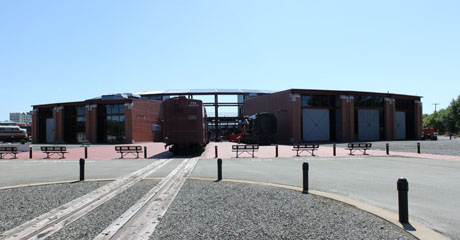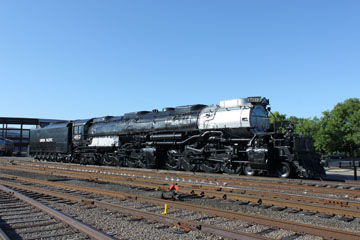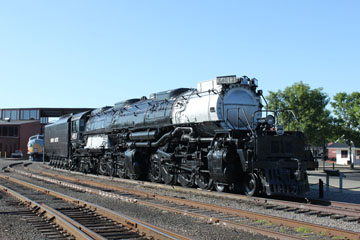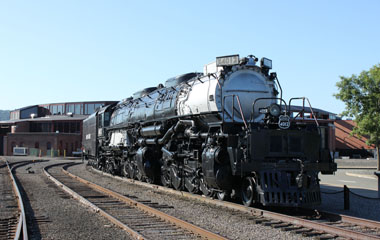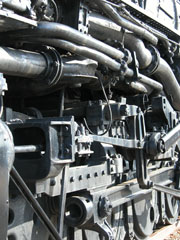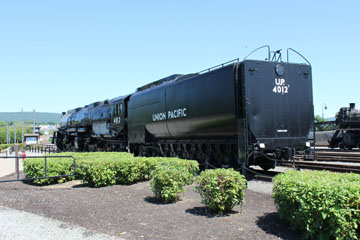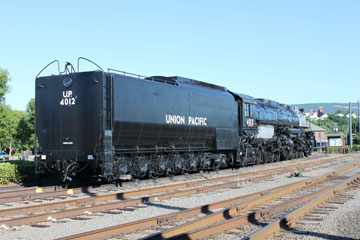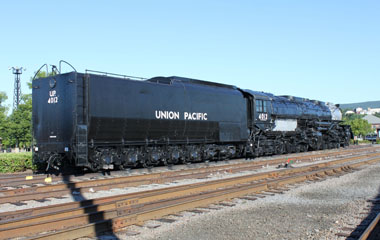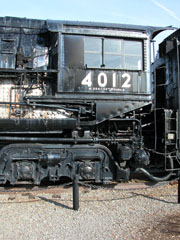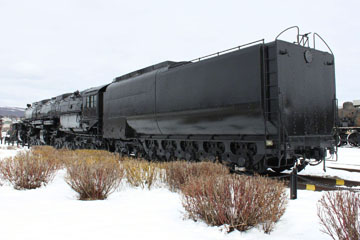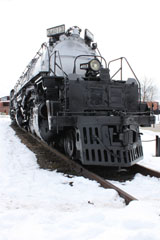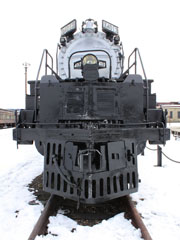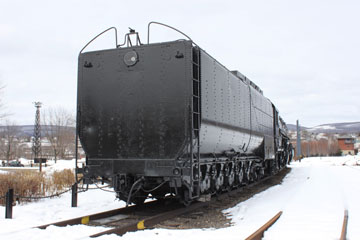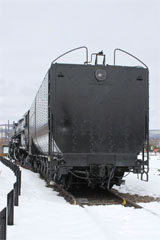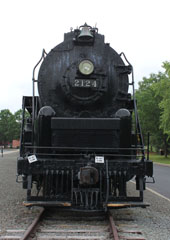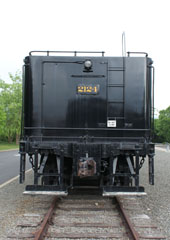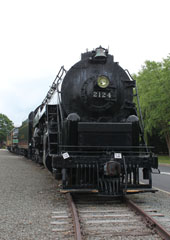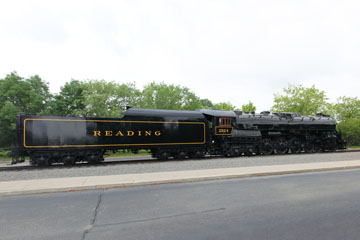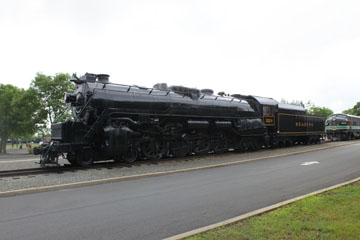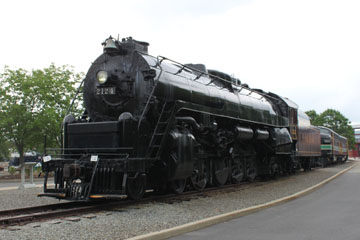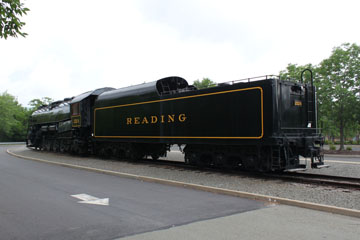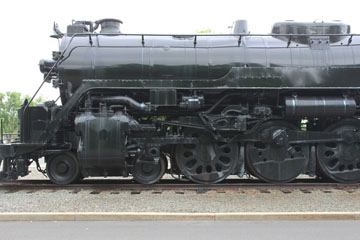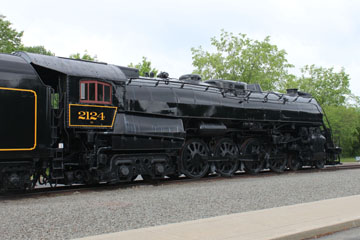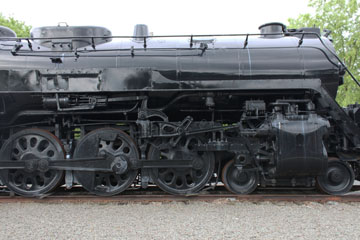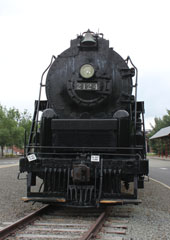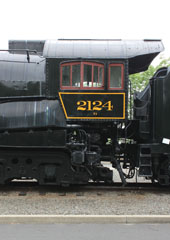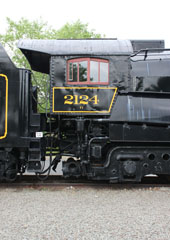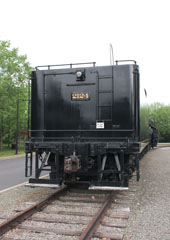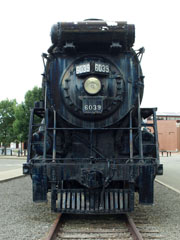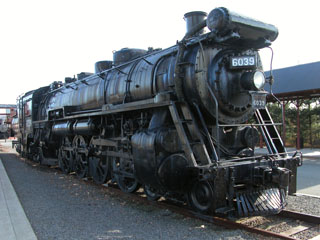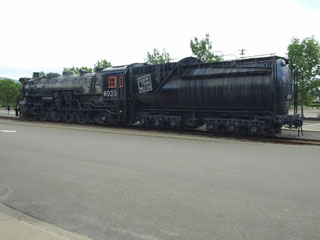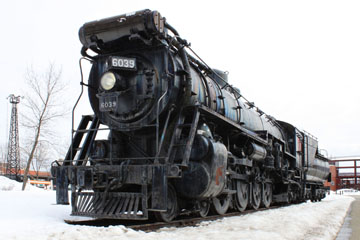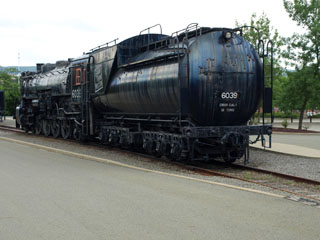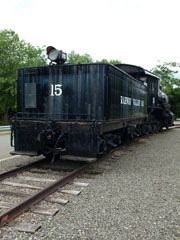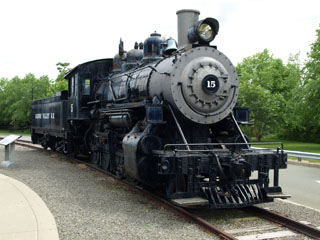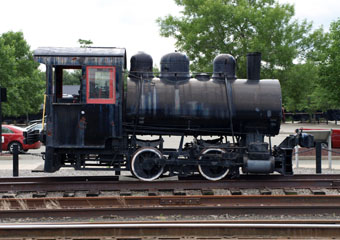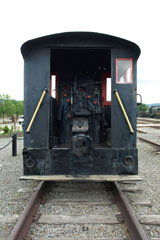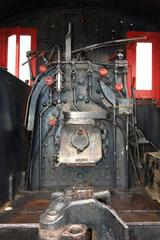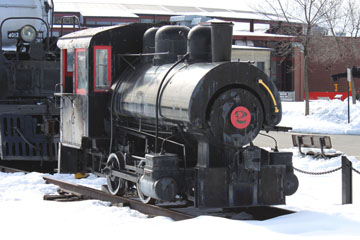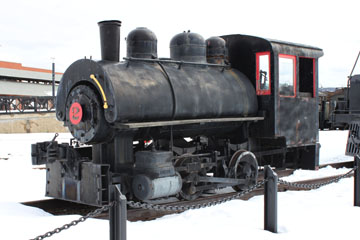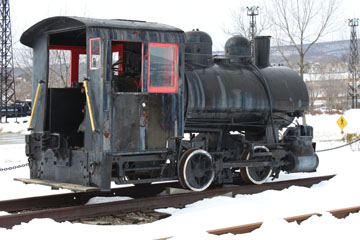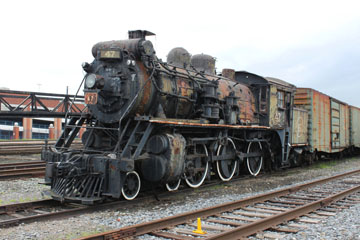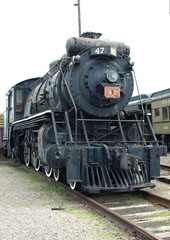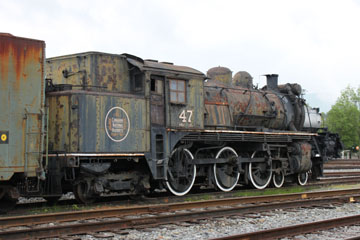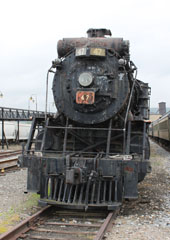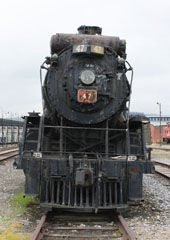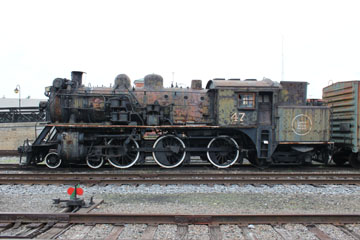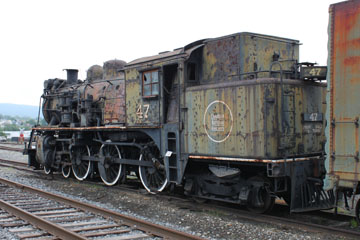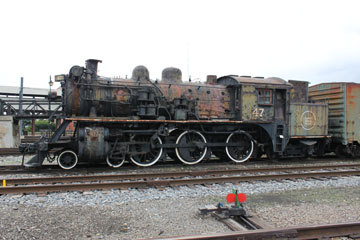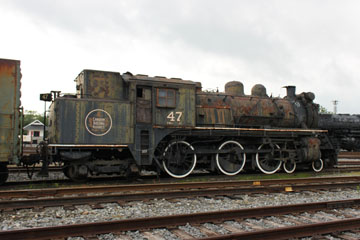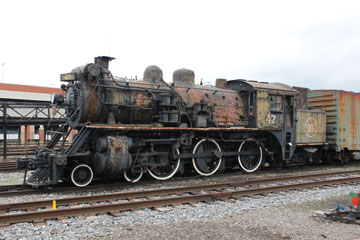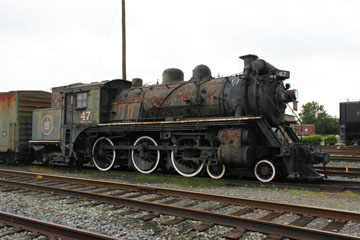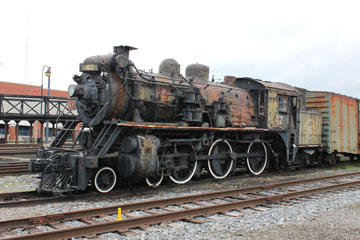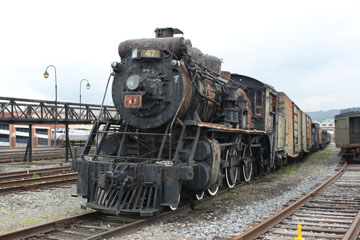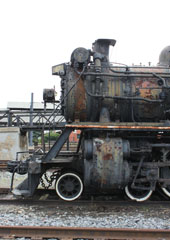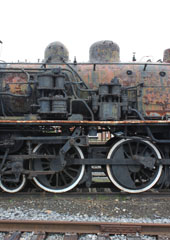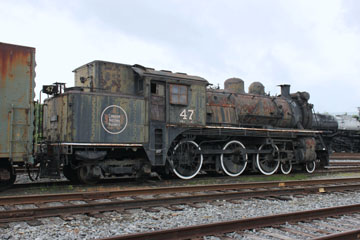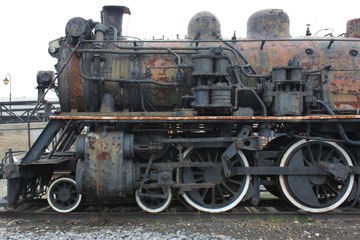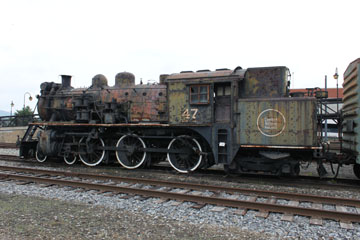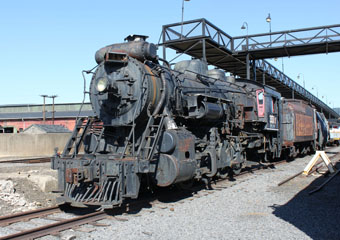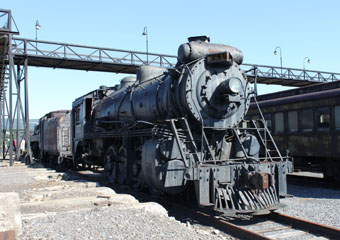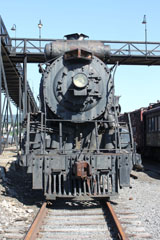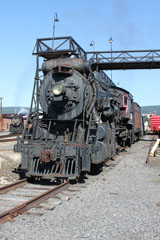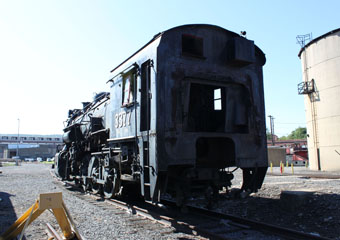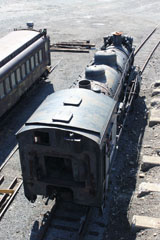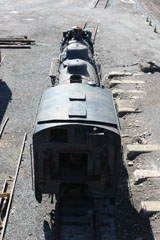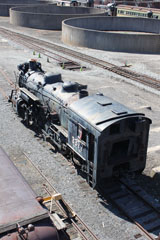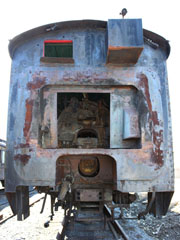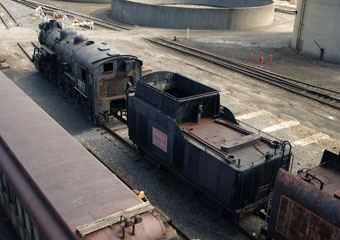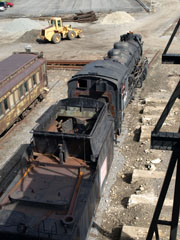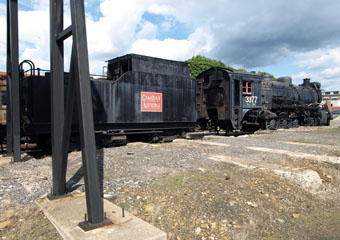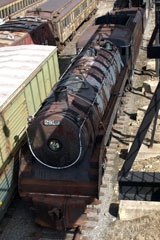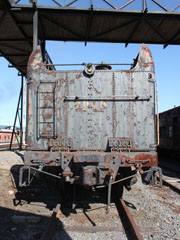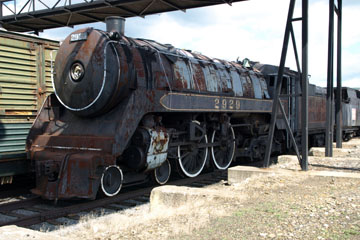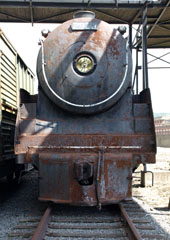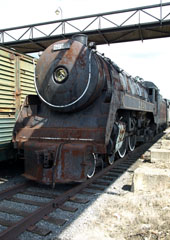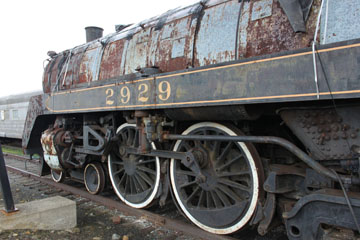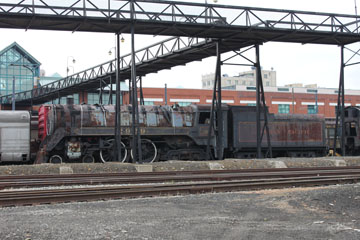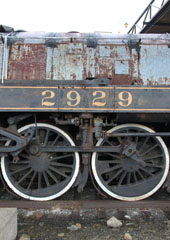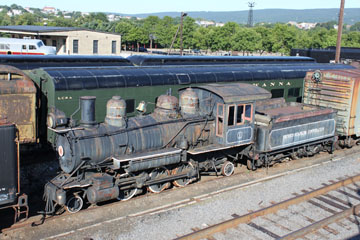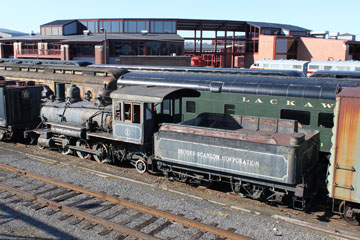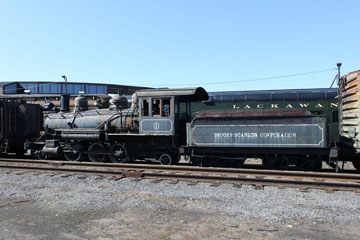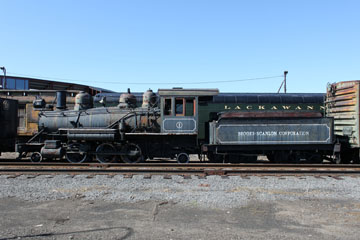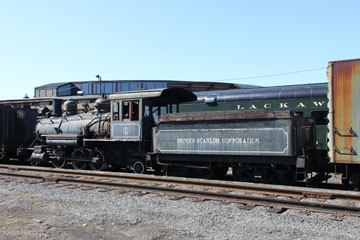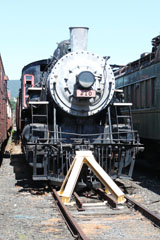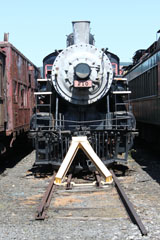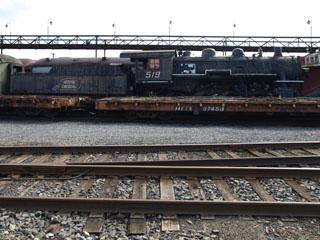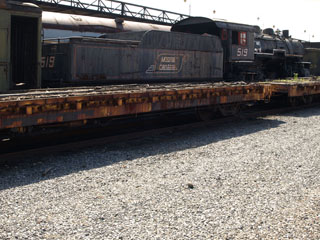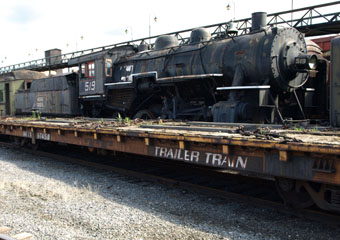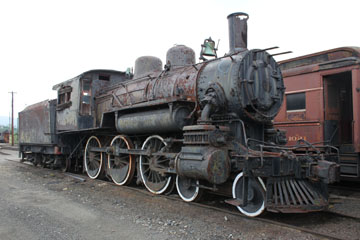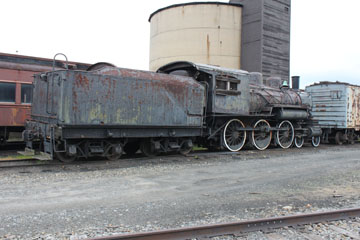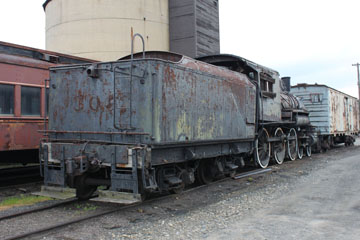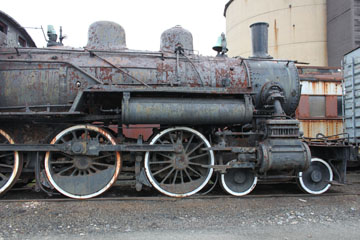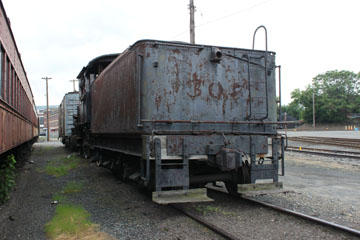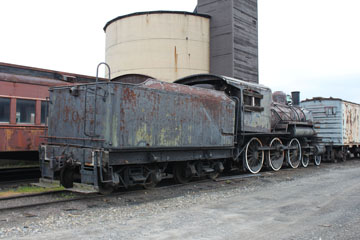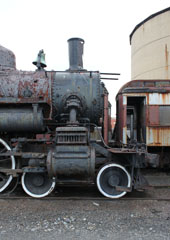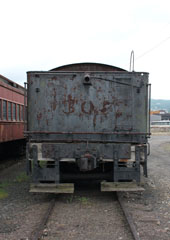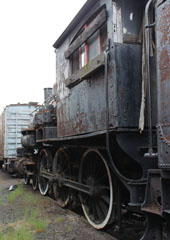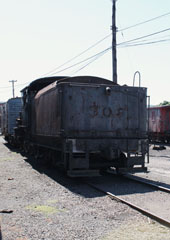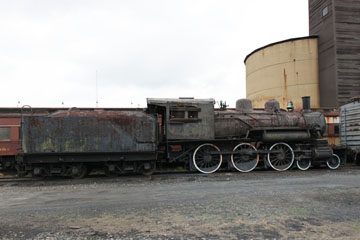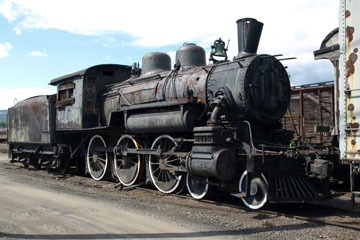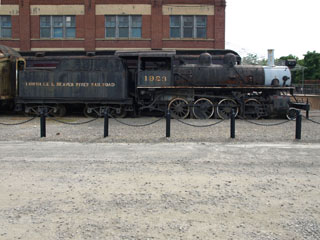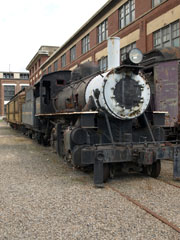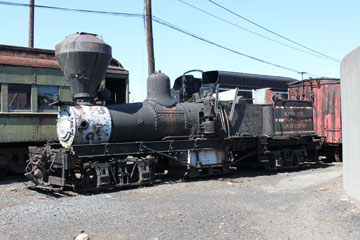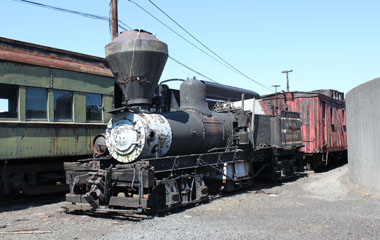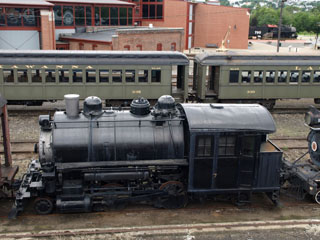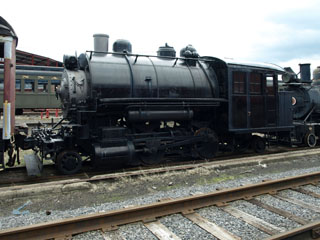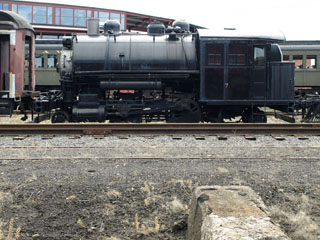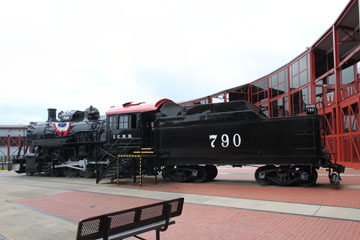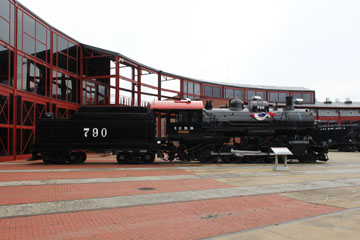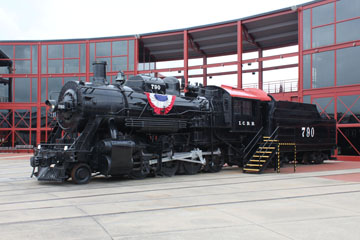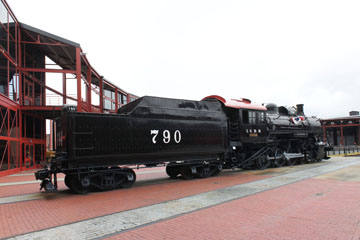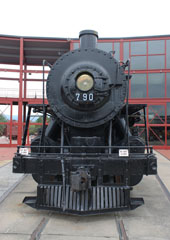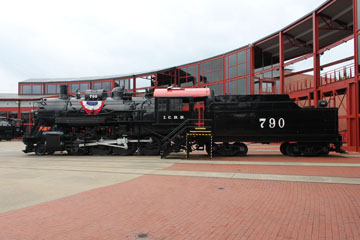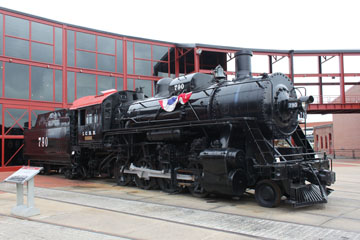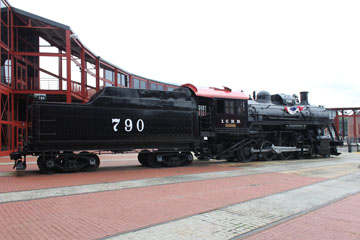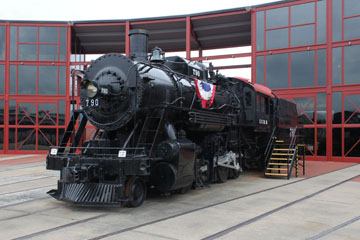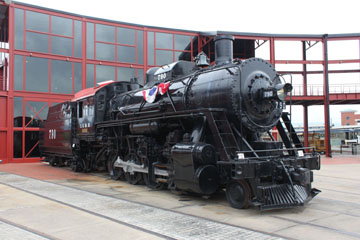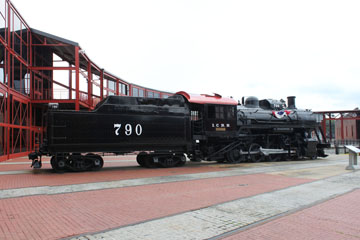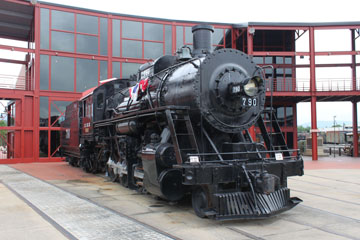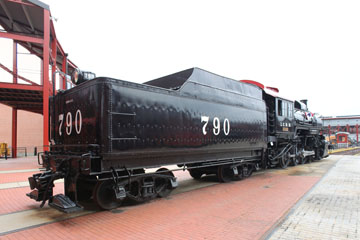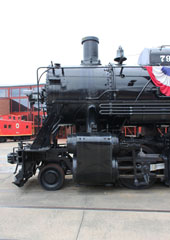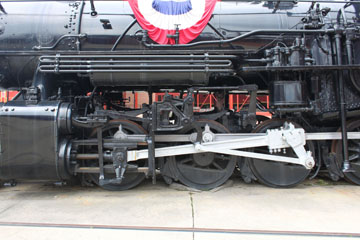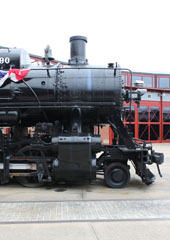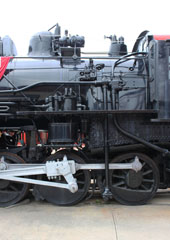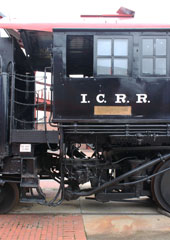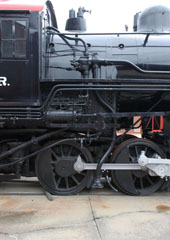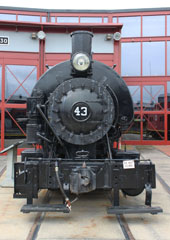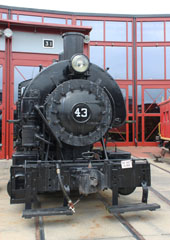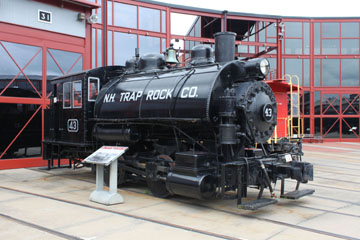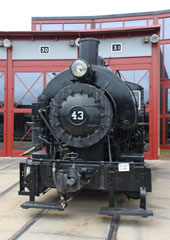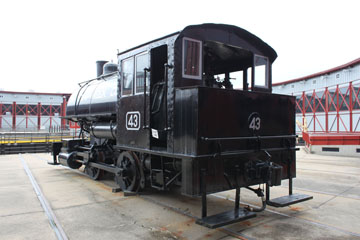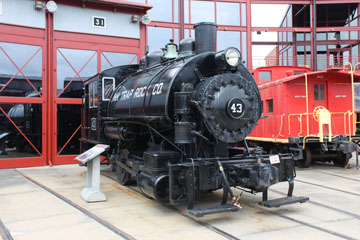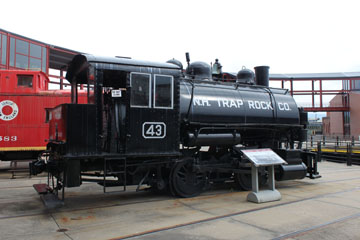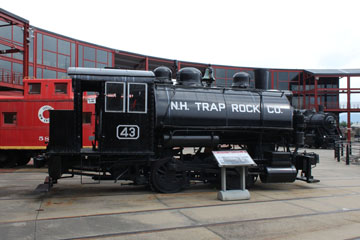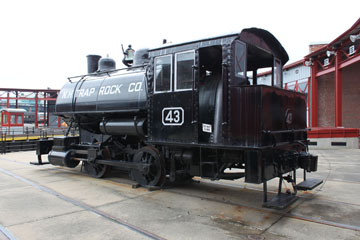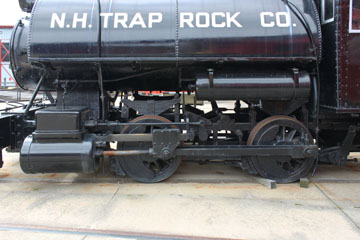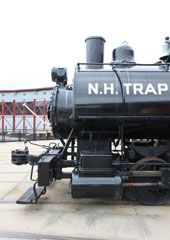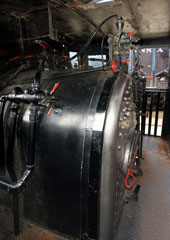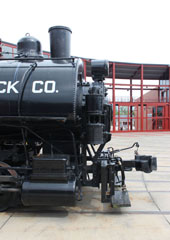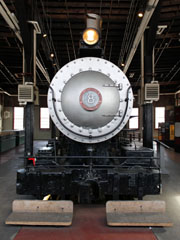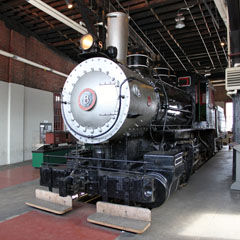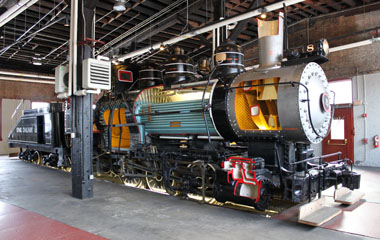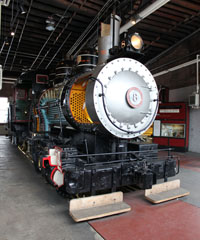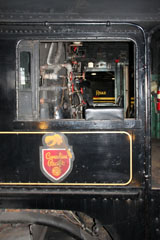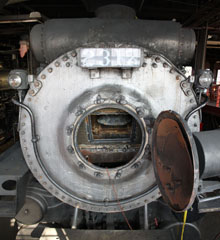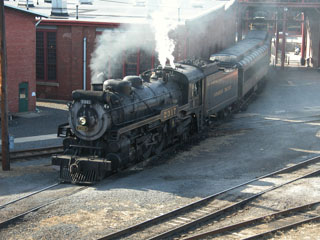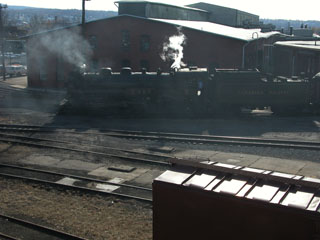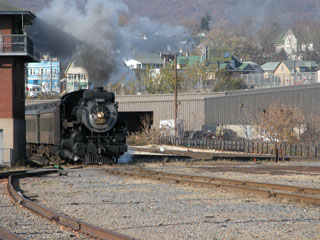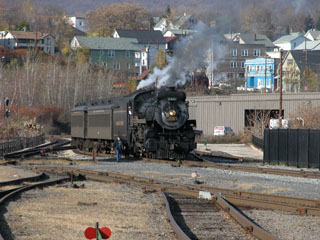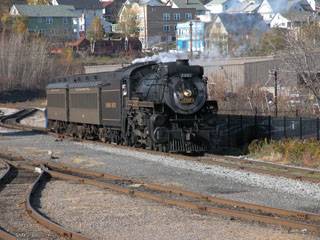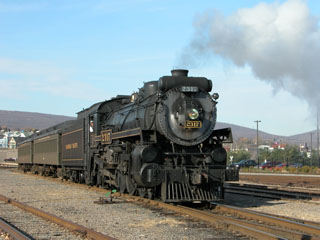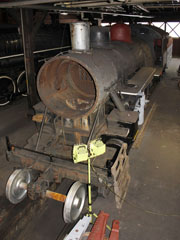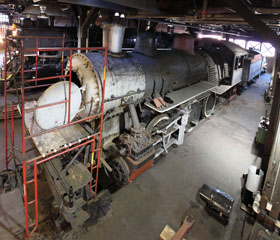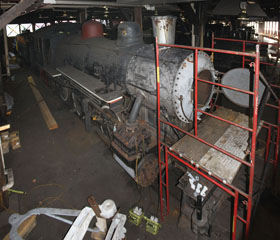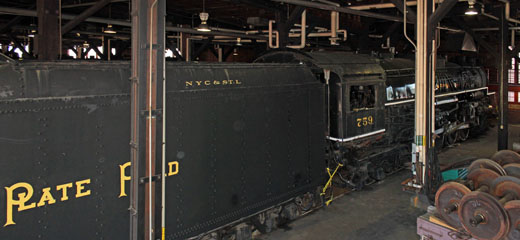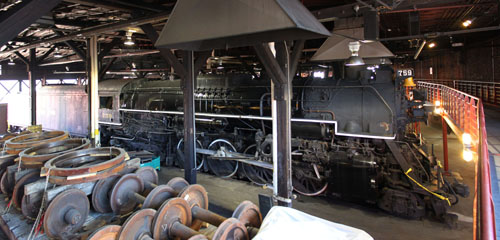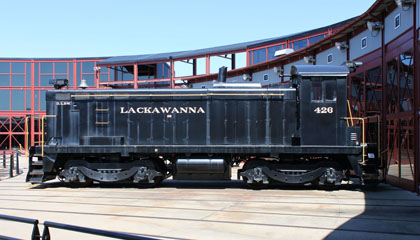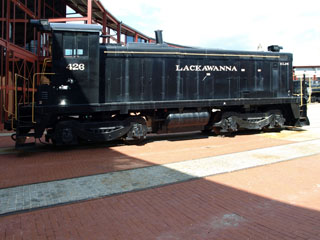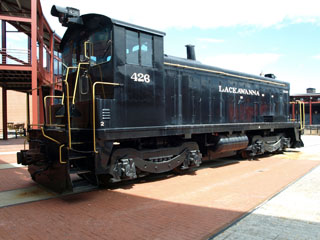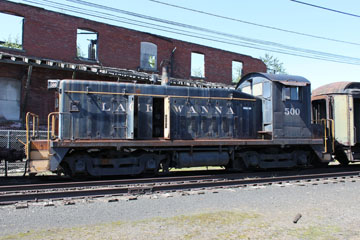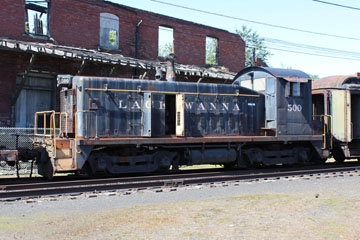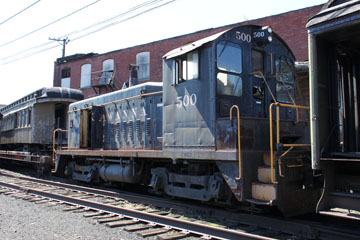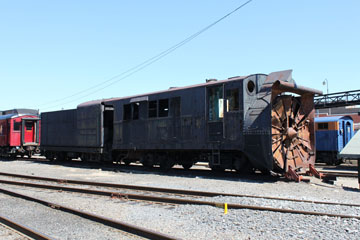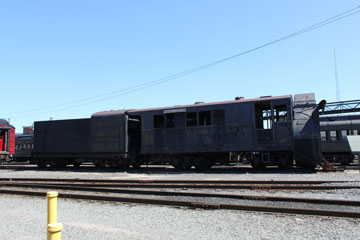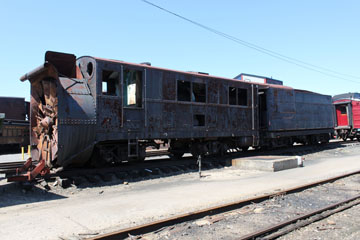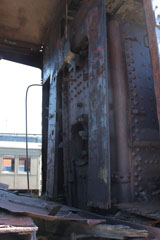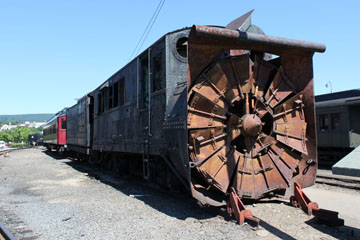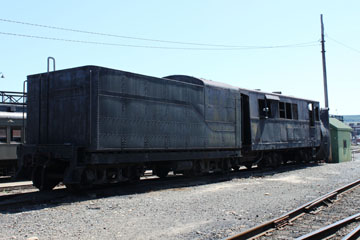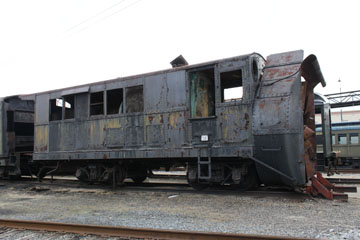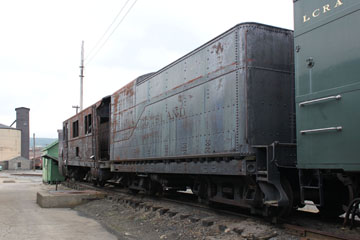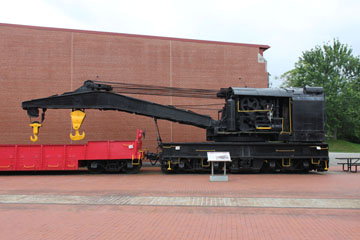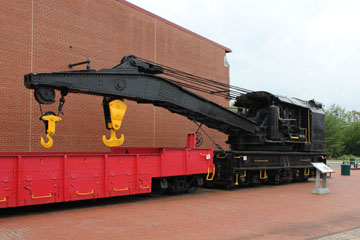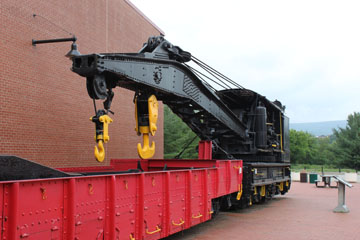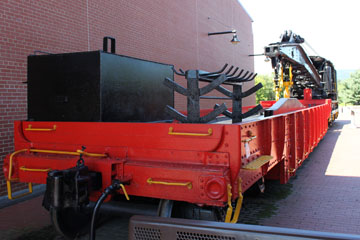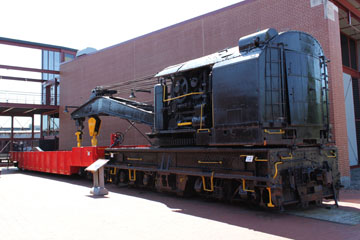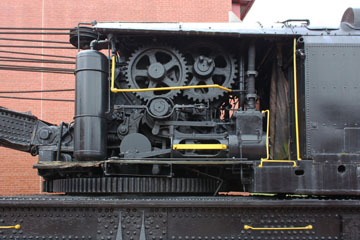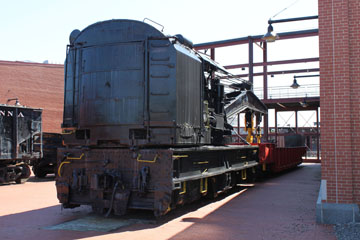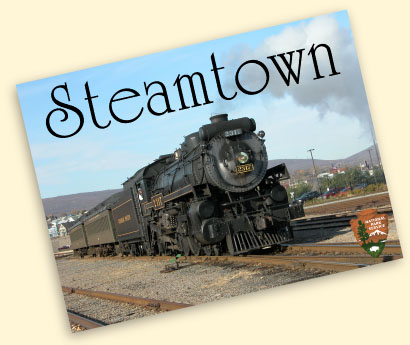

Steamtown is on Sth Bridge Ave in Scranton, PA. The museum is based on New England seafood processor F. Nelson Blount's collection of locomotives, freight and passenger cars assembled in the 1950s and 1960s, incorporated as the Steamtown Foundation. In 1984, seventeen years after Blount's death, the Foundation brought the collection to Scranton but it failed to attract enough visitors to make it a going concern and, within two years, faced bankruptcy.
In 1986, the House of Representatives, urged by Pennsylvania Representative and Scranton native, Joseph M. McDade, approved an $8 million study of the collection and began making it a National Historic Site. By 1995, Steamtown had been developed by the National Park Service at a cost of $66 million.
I have visited Steamtown a number of times and the photos on this page are from various different visits. This page features locomotives and equipment in the Steamtown collection. The Steamtown Yard page shows locomotives and other equipment stored at the museum or in the Scranton Yard

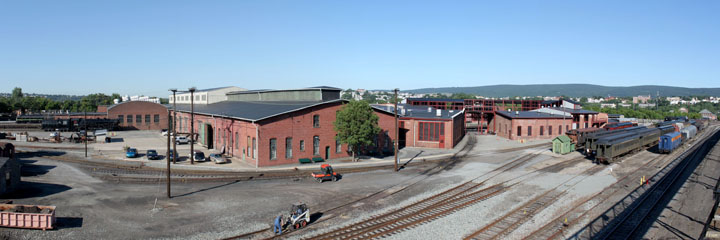
Above and right, the core of the collection is stored in and around the restored Delaware, Lackawanna & Western Railroad roundhouse.
Built in 1902 as a forty-six stall full circle roundhouse and modernised in 1937, only three original sections of the roundhouse have survived. At the centre is a working replica turntable (below).
Part of the roundhouse is still used by the museum to store locomotives in the collection, as well as to restore and repair motive power used on excursions. These operate within the museum grounds during much of the main tourist season, and there are also occasional lengthier excursions on the old DL&W Pocono main line.
You can see Canadian National 2-8-2 #3254 steaming on the CN #3254 page of this website.
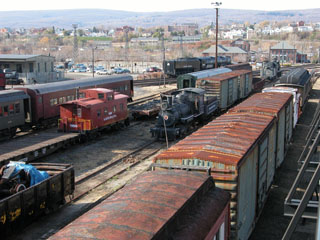
Above, some of the collection is displayed in the Scranton yard of the former DL&W.
The DL&W began with Ligget's Gap Railroad incorporated in 1832. Chartered in 1849, it changed its name to Lackawanna & Western in 1851, the year it completed a line from Scranton to Great Bend, PA. In 1853, the Lackawanna Steel Company consolidated the Lackawanna & Western with the Delaware & Cobb's Gap Railroad to form the Delaware, Lackawanna & Western.
The DL&W operated for over one hundred years. In August 1955, however, Hurricane Diane washed out much of its main line in the Poconos, suspending operations for nearly a month. The resulting operational constraints and mounting debt contributed to its merger with the Erie Railroad in 1960 to form the Erie Lackawanna. In 1976, most of EL's assets were absorbed into Conrail.
Today, the Delaware–Lackawanna Railroad is a subsidiary of the holding company Genesee Valley Transportation, operating eighty-five miles of track in Lackawanna and Monroe Counties, PA.
Right, the old DL&W Green Sand Storage Bin and Tower. Sand was transferred from the bin to locomotives' sand domes through the tower. The low circular structures are remains of disused fuel tanks.
As the DL&W dieselised, it began closing old facilities. The steam locomotive repair shop at Scranton closed in 1949. Work in the yard and shops was further curtailed when the Erie Lackawanna was formed, and the yard was finally closed in 1980 by Conrail following its 1976 acquisition of the EL.
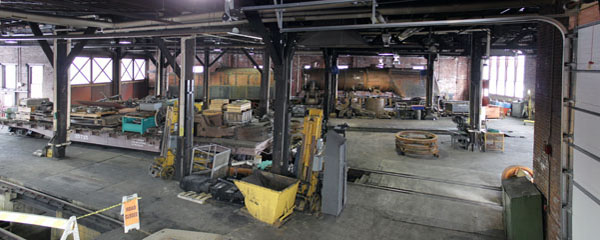
Above, some of the working bays in the roundhouse. Visitors can join a 45 minute guided tour of the roundhouse work shop, but can also visit on their own and view the locomotives from a raised walkway.
The museum visitor center, theatre and exhibition rooms have been built in the style of the original roundhouse and fill missing portions to give an impression of what the complete structure was once like. Exhibits mainly show the history of steam railroads in the US and Pennsylvania, but others show the history of early railroads, life on the railroad and the history of the Lackawanna Railroad itself.
There are various demonstrations, tours and excursions that show how railroads functioned in the age of steam. Visitors can climb in and see the controls on some of the locomotives, and a mail car, railroad executives' passenger car, boxcar, two cabooses and a recreated DL&W station are also open to walk through.


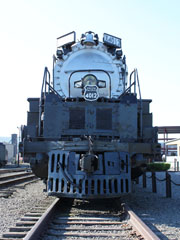
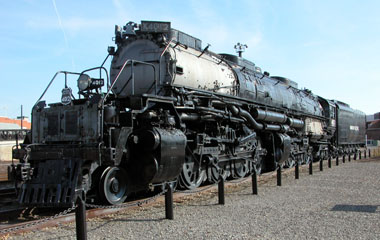
Steamtown is home to Union Pacific 4-8-8-4 Big Boy #4012.
The locomotive was built by Alco in 1948. It last operated in October 1958 and was retired in February 1962 after logging 1,029,507 miles in service. It was donated to Steamtown in 1964, when it was hauled to North Walpole, NH, the collection's first site. In 1967, it relocated with the collection to Bellows Falls, VT, and then in 1984 to Scranton. After ten years on display in front of the downtown Lackawanna Station Hotel, it was moved to the Steamtown yard.
#4012 was one of the first twenty Big Boys built in 1941 (#4000-#4019) designated "Class 1". Five
more were built in 1944, designated "Class 2" (#4020-#4024). All twenty-five locomotives were 132' 10" from front coupler to rear tender coupler. The locomotive alone was 85' 10" long. They were the only steam locomotives built with the 4-8-8-4 wheel arrangement.
The tenders were amongst the largest ever built, weighing 342,2000 lbs light with a 28 ton coal and 25,000 gallon water capacity carried on a fourteen wheel (4 + 10) centipede pedestal truck.
At 132' 9¼", #4012 is too long to fit onto Steamtown's turntable and none of the roundhouse stalls can accommodate it, so it will probably stay outdoors for the foreseeable future.
#4012 weighs 762,000 lbs, 540,000 lbs on its 68" drivers, and has an engine wheelbase of 72' 5½", 18' 9" for each driver wheelbase. With four
23½" x 32" cylinders, a 150.3 sq ft grate, 704 sq ft firebox and total heating surface of 8,355 sq ft including 2,466 sq ft superheating, it operated at a boiler pressure of 300 psi delivering 135,375 lbs tractive effort.
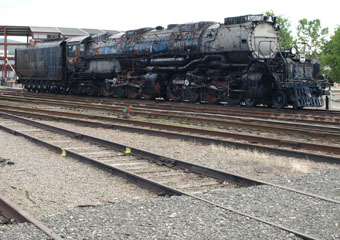
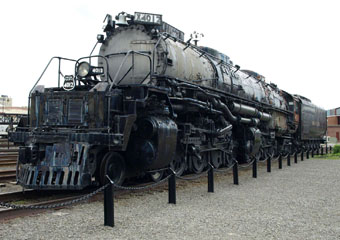
Above and right, when I visited the museum in 2009, #4012 was badly in need of a sand blast and paint job.
As you can see elsewhere on this page, however, on other occasions it has looked in tip top condition.
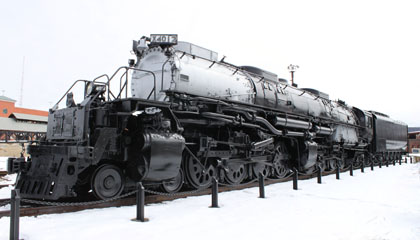
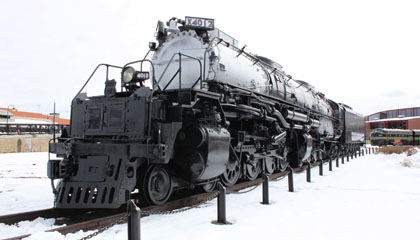
You can see more Big Boys on this website:
UP #4004 is on the Cheyenne Big Boy page, #4005 on the Forney Museum of Transportation page, #4006 on the National Museum of Transportation, St. Louis Yard, #4014 on the California RLHS, #4017 on the National Railroad Museum, #4018 on the Museum of the American Railroad and #4023 on the Kenefick Park page.

This locomotive was originally #2044, a Reading Company Class I-10 Consolidation (2-8-0) built by the Baldwin Locomotive Works in Philadelphia, PA, in 1923. It was rebuilt into a virtually new T-1 Class, #2124, in January 1947, one of thirty I-10s remodelled as T-1 Northern type (4-8-4) locomotives between 1945 and 1947 (#2100-#2129).
The Reading Company bought new underframes, wheels, boiler courses and many other new parts from Baldwin and the General Steel Casting Corporation, and carried out the conversion in its shops at Reading, PA.
The T-1 retained the I-10's 94.4 sq ft grate and 465 sq ft Wootten firebox, designed to burn anthracite coal, as well as the 27" x 32" cylinders, but the first two boiler courses were replaced with new 187" extensions with new tubes and flues, as well as a very long 111" smokebox. Total heating surface was 6,134 sq ft including 1,214 sq ft superheating. Operating at a boiler pressure of 240 psi, it delivered 67,984 lbs tractive effort.
At the same time, the 61½" drivers were replaced with 70" Boxpok drivers. New feedwater heaters, boosters and tenders were also supplied.
The first twenty T-1s were designed to haul freight, largely coal traffic, the last ten to haul passenger trains but, except for a few troop trains, mainly hauled freight. They worked until 1956, when all steam was retired on the RDG.
The company kept only four steam locomotives: T-1s #2100, #2101, #2102 and #2124. In 1959, #2124 re-entered active service on the first of the "Iron Horse Rambles", also known as the "Reading Rambles", on 16th October, hauling sixteen passenger cars full of railfans from Wayne Junction to Shamokin, PA.
Right, in 1959, #2124 made a brief appearance in the opening scenes of the film From the Terrace with Joanne Woodward and Myrna Loy, shot at Jersey City, NJ.
The Reading Company ran fifty-one "Iron Horse Rambles" excursions from 1959 to 1964, also utilising T-1s #2100 and #2102. The last excursion ran on 17th October 1964. However, #2124 was taken out of service after a trip in October 1961 and was then sold to F. Nelson Blount in 1962 and joined the Steamtown collection. You can see T-1 #2101 on the B&O Museum Yard & Car Shop page of this website, although it was never used on the "Iron Horse Rambles".


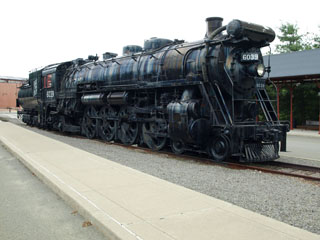

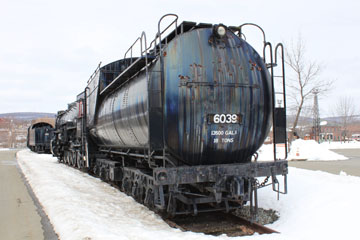
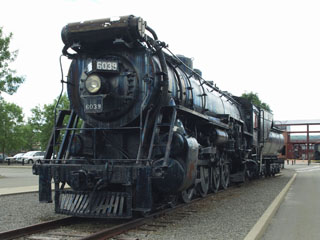
#6039 is one of five Mountain type (4-8-2) U-1c class locomotives rostered by the Grand Trunk Western, all built by Baldwin in 1925 and the only GTW 4-8-2 to survive. Fitted with feedwater heaters, power reverse gear and automatic or mechanical stokers, they were the first locomotives on the GTW to feature both Vanderbilt tenders and enclosed, all-weather cabs.
Although designed for passenger service, the Grand Trunk Western soon put them to work on fast freight trains.
In the late 1950s, #6039 was leased to the Central Vermont Railway. It was bought by Blount in 1959 for $7,425.
#6039 weighs 354,110 lbs, 231,370 lbs on its 73" drivers. The grate was 66.7 sq ft and the 307 sq ft firebox included 27 sq ft in four arch tubes and a 74 sq ft combustion chamber. With 26" x 30" cylinders and total heating surface of 5,086 sq ft including 1,048 sq ft superheating, it operated at a boiler pressure of 210 psi delivering 49,590 lbs tractive effort.
During their careers, the U-1cs received a number of modifications. During the mid-1930s, their friction bearings were replaced with roller bearings. In 1940 and 1941, smoke deflectors were fitted for a time and, during the 1940s, Boxpok drivers progressively replaced the original spoked wheels. The engines were also reportedly fitted with Vanadium steel mainframes.
With heavier steam power and, later, dieselisation, the U-1cs were moved onto passenger runs in the 1940s and 1950s.

This Consolidation (2-8-0) type locomotive was built by Baldwin in 1916 for the Oneida & Western in Oneida, TN, as #20. In 1937, it was sold to the Rahway Valley Railway at Kenilworth, NJ, and renumbered #15.
The Rahway Valley was a New Jersey shortline that operated from 1897 until 1992. During the first few decades of the 20th century, it was one of the most successful shortline railroads in US history. #15 joined three other Consolidations at the Rahway (#12, #13 and #14), and worked until 1951.
F. Nelson Blount bought #15 in 1959, initially for display at the new Pleasure Island Park in Wakefield, MA.
After moving to North Walpole, MA, Blount had #15 overhauled and put back into service on his tourist Monadnock, Steamtown & Northern Railroad.
#15 weighs 142,000 lbs, 126,000 lbs on its 50" drivers. It has 20" x 26" cylinders, a 29.5 sq ft grate,144 sq ft firebox and total heating surface of 1,889 sq ft. Operating at a boiler pressure of 200 psi it delivered 35,360 lbs tractive effort.
The tender weighs 100,000 lbs light.
The original slide valves were converted to piston valves in 1926 when it underwent repairs at Baldwin's Eddystone plant and the branching outside steam pipes were fitted.
The Rahway bought its first diesel in 1951, and #15 worked relief when the diesel needed repair until 1953.
The locomotive steamed from 1962 to 1967 so reliably that it came to be called the "Faithful Fifteen".
Taken out of service because its flue licence had expired, it returned briefly to service in 1973 but, after blowing a flue on another excursion, it was retired for good.

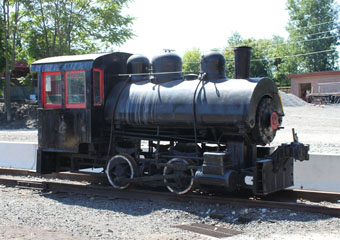
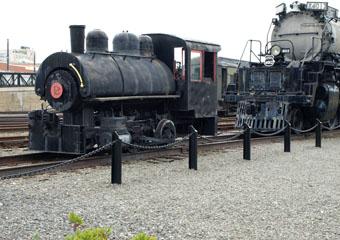
H. K. Porter built this 0-4-0T (Tank) oil burning locomotive for the Bullard Company of Bridgeport, CT, in 1937. #2 weighs 30,000 lbs and has 26½" drivers and 9" x 14" cylinders. Operating at a boiler pressure of 170 psi, it delivered 6,180 lbs tractive effort.
Incorporated in Connecticut in 1894, the Bullard Machine Tool Company manufactured machine tools of various kinds over the next century, many for use by the railroad industry. The company changed its name to the Bullard Company in 1929.
#2 was the second locomotive bought by the company, and was probably operated by a lone engineer/fireman. It appears to have worked hard during its service life: the front breast beam and coupler have both been replaced,
and the saddletank is probably also a replacement.
After some twenty or thirty years working for Bullard, it was sold to the used locomotive dealer American Machinery Corp., from whom Blount purchased it in 1963. #2 has remained in the Steamtown collection ever since.

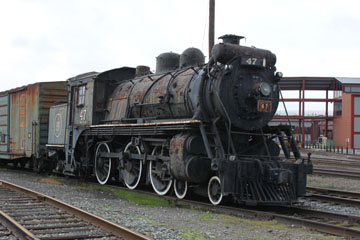
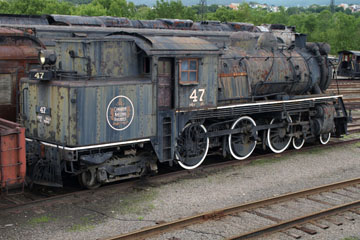
This is one of six 4-6-4T (Tank) locomotives built for the Grand Trunk Railway by the Montreal Locomotive Works in 1910 (#1540-#1545). They were designed for commuter services between the suburbs and centre of major Canadian cities, in this case, Montreal. Originally numbered #1542 when it operated on the Grand Truck, it was renumbered #47 soon after the GTR was consolidated into Canadian National in 1923.
At the time, the wheel arrangement was given the name "Baltic Tank", as the the 4-6-4 main line locomotive did not appear until 1927.
#47 weighs 275,000 lbs. With 21" x 26" cylinders, 63" drivers, a 47 sq ft grate, 160 sq ft firebox and 2,128 sq ft heating surface (including 342 sq ft superheating) it operated at a boiler pressure of 210 psi delivering 32,487 lbs tractive effort.
#47 was retired some time before 1959, the year it was bought by Blount for $2,000. It steamed briefly on the Monadnock, Steamtown & Northern Railroad in New Hampshire, but it was found to have no official papers (they were burned in a CNR roundhouse fire). The fire was therefore dropped for good on 26th August 1961.


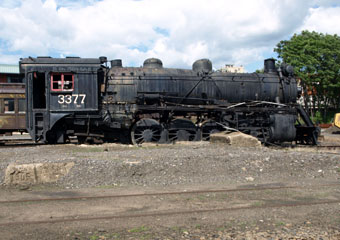
The Canadian Locomotive Company built this Mikado type (2-8-2) locomotive at its works in Kingston, Ontario, in 1919. Built as Canadian Government Railways #2977, it was immediately renumbered Canadian National #3377 with consolidation of the new company.
Canadian National Railways was created between 1918 and 1923 out of several railroads that had become bankrupt and fallen into Federal Government hands, along with some already owned by the government such as Canadian Government Railways.
#3377 was sold to F. Nelson Blount by
Canadian National in 1961 and moved with the collection to Scranton in 1985. It was built only two years after CN #3254, also owned by Steamtown, and it appears #3377 is used to provide spare parts for the older locomotive, which perhaps explains its dilapidating condition.
Steamtown's other Canadian National S class locomotive still operates, and you can see photos of it steaming on the CN #3254 page of this website.
Designed for freight service, #3377 underwent a number of modifications, including being fitted with a superheater, feedwater heater, mechanical stoker and large-capacity air pumps for the braking system, allowing it to haul long main line freight trains.
A coal burner, #3377 weighs 272,100 lbs, 204,700 on its 63" drivers. With 27" x 30" cylinders, a 56½ sq ft grate, 289 sq ft firebox and 4,155 heating surface (including 804 sq ft superheating), it operated at a boiler pressure of 180 psi, delivering 53,115 lbs tractive effort.

#2929 weighs 240,000 lbs has 75" drivers and
16½" x 28" cylinders (the F-2-a weighed 263,000 lbs, had 80" drivers and 17¼ x 28" cylinders). With a 45 sq ft grate, 200 sq ft firebox and 3,191 sq ft heating surface, including 900 sq ft superheating, #2929 operated at a boiler pressure of 300 psi, delivering 25,918 lbs tractive effort. Although also operating at 300 psi, the F-2-a had a 55.6 sq ft grate, 232 sq ft firebox, 3,933 sq ft heating surface and delivered 26,557 lbs tractive effort.
#2929 is the sole surviving F-1-a. No F-2-a locomotives have survived.
This Canadian Pacific 4-4-4 was built in 1938 by the Canadian Locomotive Company at its Kingston, ON, works.
It is the last of twenty F class locomotives (#2910-#2929) built from 1936 to 1938 to haul lightweight passenger trains.
Five F-2-a 4-4-4 type locomotives had been built for the Canadian Pacific by the Montreal Locomotive Works in 1936 (#3000-#3004).
The F-2-a was heavier and larger, but all the CPR F class locomotives featured similar streamlining.
When the first F-2-a was outshopped in 1936, the name "Jubilee" was given to the wheel arrangement to mark the 50th anniversary of Canadian Pacific's inauguration of its transcontinental service in 1886.
The fast, local intercity services for which the Fs were designed never developed, however, and the locomotives were assigned to work on local passenger services on the prairies and in eastern Canada instead. #2929 continued in service until 1958 and was bought by F. Nelson Blount the following year.

A Baldwin product, #1 is a Prairie type (2-6-2) locomotive delivered in 1914 to the Carpenter-O'Brien Lumber Company to work at the company's Eastport, FL, saw mill.
Carpenter-O'Brien was one of the many concerns milling the extensive native pine stands in the South at the turn of the 20th Century, and even owned a ship, the S.S. "William J. O'Brien", which hauled two million board feet of lumber per trip to its yard on Staten Island, NY. In 1917, the Florida mill and timber holdings were sold to the Brooks-Scanlon Corporation.
The Brooks-Scanlon Corporation started out in 1896 operating saw mills in Minnesota. In 1910, when the lumber stands were exhausted there, the company moved to Oregon, where it had purchased two large tracts of Ponderosa pine in 1905. At that time, it also bought stands of timber in Louisiana.
By 1917, however, it was apparent that the Louisiana plant would eventually run out of timber, which finally happened in 1923. So, the company bought out Carpenter-O'Brien's Eastport mill and, in the process, acquired #1.
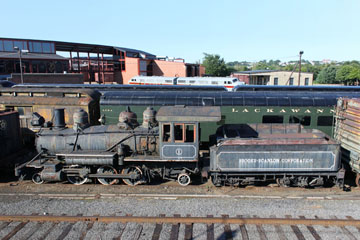

It's not known if #1 was used to haul logs to the mill from the woods, to switch in the Eastport yard or both but, in 1929, the mill was closed. At some point, ownership of #1 then passed to either the Lee Cypress Company or, still later, to the Lee Tidewater Cypress Company, switching at a mill in Perry, FL.
In 1962, the company was dissolved, probably because the lumber had been completely milled out, and its five surviving locomotives, including #1, were sold to F. Nelson Blount. #1 never steamed again.
#1 weighs 82,900 lbs. The engine wheelbase is 24' 9" and the driver wheelbase 9' 2". It has 16" x 24" cylinders and 42" drivers. The grate is 16 sq ft and the firebox 112 sq ft. Total heating surface is 15,94 sq ft and, operating at a boiler pressure of 175 psi it delivered 21,364 lbs tractive effort. The tender weighs 70,000 lbs light.
#1 could burn either coal or wood and may originally have been fitted with a Rushton or cabbage stack, designed to catch cinders from wood burning locomotives. If so, a later owner fitted the present "shot gun" stack.

Tucked away behind NJT #3503 (shown later on this page) #210 is a Mogul type (2-6-0) locomotive built by Alco in 1923 for the Norwood & St Lawrence Railroad.
Because of its positioning, I was only able to get these front on photos of it.
At Waddington, a ferry connected across the river to Morrisburg, ON.
The railroad also interchanged traffic to the south and west with the New York Central Railroad at Norwood, and to the east with the Rutland Railroad.
The Norwood & St Lawrence's 7½ mile Norwood to Raymondville, NY, line opened in 1901.
In 1909, it absorbed the Raymondville & Waddington Railroad, and soon completed its 18 mile line to Waddington on the St. Lawrence River.
In 1956, the last of the paper mills closed and the railroad bought a small diesel locomotive.
Late that year, #210 was shipped to Abe Cooper-Watertown Corp's scrapyard in Watertown, NY. Five years later, it was bought by Blount.
With paper mills in Raymondville, Norwood and Norfolk, hauling paper pulp became one of the most important functions of the line.
In 1920, the St. Regis Paper Co., bought all three paper mills, as well as the Norwood & St. Lawrence.
A coal burner, #210 weighs 148,000 lbs. It has 56" drivers and 20" x 26" cylinders. Operating at 180 psi, it delivered 28,400 lbs tractive effort.
With business in decline, the Norwood & St. Lawrence discontinued service in 1973.

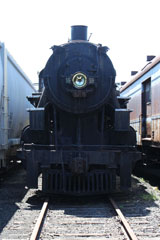
#519 is one of eight Consolidation (2-8-0) type locomotives built by Alco for the Maine Central in 1913 (#517-#524).
The MEC already owned sixteen of these high-boilered, low tender W class locomotives designed to haul fast freight.
#519 worked the entire MEC system until retired in 1950 and stored at the railroad's Waterville roundhouse.
In 1960, it appeared in Sunrise at Campobello, filmed at Eastport, ME, about future President F. D. Roosevelt contracting Polio at his Summer retreat island.
During filming, it had a coal fire over half its grate to produce smoke during a departure scene from Eastport but was, in fact, being moved by an MEC GE 44 ton switcher. The train sounds were mixed in post production.
#519 stayed with the MEC until 1963, when it was sold to Blount.
#519 weighs 198,000 lbs, 172,500 lbs on its 63" drivers. It has an engine wheelbase of
25' 6" and driver wheelbase of 17'. With 23" x 28" cylinders, a 56.5 sq ft grate, 186.8 sq ft firebox and total heating surface of 2,735 sq ft including 433 sq ft superheating, it operated at a boiler pressure of 185 psi delivering 37,000 lbs tractive effort. The tender weighs 136,100 lbs light, and has a 6,500 gallon water and 11 ton coal capacity.

In 1905, the Nickel Plate bought ten Ten Wheeler type (4-6-0) locomotives from the Brooks Locomotive Works, #40-#49 designated class P and another twenty in 1906. In 1910, all the Class Ps were renumbered from #40-#54 to #300-#314, with #44 becoming #304. Weighing 136,500 lbs, 105,600 lbs on their 62" drivers, they had 21" x 24" cylinders and operating at a boiler pressure of 180 psi, delivered 21,040 lbs tractive effort.
In 1920, the NKP sold twelve, including #304, to the Akron, Canton & Youngstown. In 1929, #304 was sold on to the Dansville & Mount Morris.
#304 worked on the Dansville & Mount Morris Railroad, a shortline in upstate New York, until retired in 1957, when it was sold to Myers Steel and Supply Company, a scrap dealer. However, Myers never took #304 from the railroad's property and, in 1963, Blount learned of its existence and bought it for $1,256.
#304 is the only surviving steam locomotive to have worked on the Akron, Canton & Youngstown Railroad, and one of only two Dansville & Mount Morris locomotives to have survived. You can see the other, #565, later on this page.

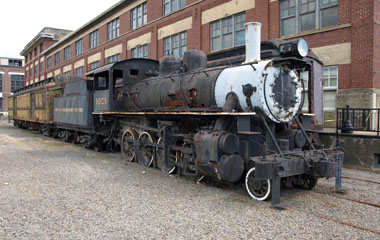
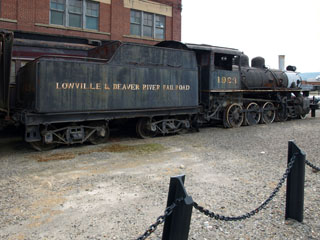
Built by Alco for the Cuban sugar plantation
Compañía Azucarera Central Reforma as #8 in 1920, for reasons that remain unclear, this little Consolidation (2-8-0) type locomotive was never shipped to Cuba. Instead, in 1923, it was bought by the Lowville & Beaver River Railroad, a shortline operating in New York State west of the
Adirondacks.
Built as an oil burner, before shipping it to L&BR's Lowville, NY, base, Alco removed the locomotive's oil burner from the firebox and oil tank from the tender and converted the grates to burn coal.
As the L&BR had done since buying its first new locomotive from Alco in 1912 (#1912), #8 was renumbered #1923, the year of its purchase.
#1923 worked on the L&BR hauling freight and passenger trains until January 1947, when passenger services stopped, although it continued hauling freight serving local farmers, paper mills and a block factory at Croghan, NY, until May 1947. It was then placed on standby with the arrival of a 44 ton GE diesel-electric #1947.
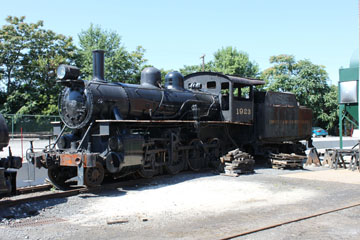
Above, on my most recent visit, #1923 was parked behind the museum workshop. The boiler and cylinders appeared to have been recently painted, but parts of the engine and tender were still looking a little the worse for wear.
After the arrival of #1947, the other Lowville & Beaver River steam locomotive, #1912, was soon sold for scrap, but #1923 went into storage. For a brief period of four months in 1954, the
locomotive steamed again while the company's diesel underwent repairs, and then again in January 1957, when cold completely disabled the diesel. That, however, was its last stand. #1923 was sold to Blount in 1964 for $2,000. The locomotive apparently moved to Bellows Falls, VT, in October of that year.
#1923 weighs 122,500 lbs, 106,500 on its 50" drivers. With 18" x 22" cylinders operating at a boiler pressure of 178 psi, it delivered 28,400 lbs tractive effort. The tender has a capacity of 1,800 gallons of oil and 5,000 gallons of water.
In 1993, the L&BR was purchased by Genesee Valley Transportation. You can see some of GVT's current motive power on the Steamtown Scranton Yard page of this website.

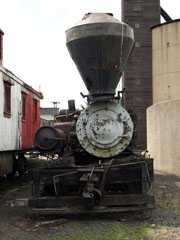

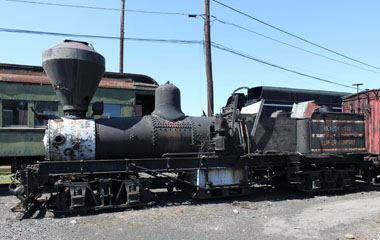
As built, this coal burning locomotive weighed 86,000 lbs. It has 29½" drivers and 10" x 12" cylinders. Operating at a boiler pressure of 180 psi, it could deliver 16,900 lbs tractive effort. It was sold to F. Nelson Blount in 1959.
You can see a wealth of Shays in operation, including the largest surviving one, on the Cass Scenic Railroad page of this website. There are also Shays on the B&O Museum Roundhouse page, the Travel Town page, the Railroad Museum of Pennsylvania Train Shed page and the North Carolina Museum of Transportation page.
This somewhat dilapidated two truck Shay locomotive was damaged in a roof collapse at Bellows Falls, VT, due to heavy snow in 1982 and has never been repaired.
It was built by Lima in 1910 to work Sewell Valley Railroad's twenty miles of track from an interchange with the Chesapeake & Ohio at Meadow Creek, WV, to the site of the Meadow River Lumber Company's new mill at the mouth of Sewell Creek. The Sewell Valley Railroad was a subsidiary of the lumber company, and #1 was the first locomotive it purchased.

#7 worked for another twelve years at Groveton until retired in 1956, when it was replaced with a secondhand 45 ton GE
diesel-electric. The locomotive then went
into storage until 1961, when it was leased to the Woodsville, Blackmount & Haverhill Railroad.
#7 operated for only one year on the excursion railroad between Woodsville and Blackmount, NH, and then sat idle until 1969, when the Groveton Papers Company donated it to Steamtown.
A 2-4-2T (Tank) locomotive, #7 was built by the Vulcan Iron Works, Wilkes-Barre, PA, in 1911 for the Berlin Mills Railway in Berlin, NH. By 1926, the company owned three Vulcan built tank locomotives amongst its nine engine roster.
#7 worked for Berlin Mills for thirty-three years but was eventually rendered obsolete as the company grew and acquired heavier motive power. The locomotive was sold to the Groveton Papers Company in nearby Groveton, NH, in 1944.
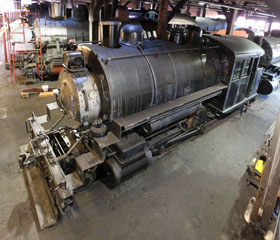
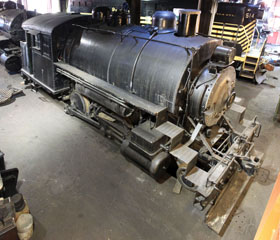
Above, when I last visited, #7 was in the roundhouse.
#7 weighs 114,000 lbs, has 44" drivers and 17" x 24" cylinders. Operating at a boiler pressure of 140 psi, it delivered tractive effort of 21,720 lbs.
It is one of only four standard gauge
2-4-2T type locomotives to have survived in the US. This was once a quite common type on logging
railroads and on industrial plant trackage.

Built by Baldwin as #100 for the Chicago Union Transfer Railway in 1903, this Consolidation type (2-8-0) locomotive was one of four sold to the Illinois Central in 1904, where it was renumbered #641. Designed to haul freight trains, #641 was probably better utilised by the IC than it would have been if it continued working in Chicago's Union Station transfer yard.
#641 hauled freight in Tennessee for most of its life, and must have seen hard service, as it was rebuilt in 1920 with a superheater and, possibly, replacement boiler and firebox.
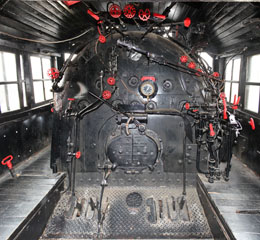
The engine weighs 183,100 lbs, 161,000 lbs on its 51" drivers. With 22" x 26" cylinders, a 48 sq ft grate and 175.4 sq ft firebox, total
heating surface was 1,953 sq ft, including 440 sq ft superheating. Operating at a boiler pressure of 200 psi, it delivered 41,947 lbs tractive effort.
It was renumbered #790 in 1940,
and remained on the IC roster until near the end of steam. In 1959, #790 was sold to Louis S. Keller of Cedar Rapids, IA, who planned to use it on railfan excursions between Cedar Rapids and Manchester, IA,
although the excursions never eventuated.
In 1965, #790 was sold to David de Camp, who moved it to Lake Placid, NY, hoping to operate it there. However, it never steamed again, and was sold to Blount in 1966. It is the only Chicago Union Transfer locomotive to have survived.

This 0-4-0T (Tank) locomotive was built by the Vulcan Iron Works, Wilkes-Barre, PA, in 1919 for C. W. Blakeslee & Sons of North Branford, CT, later the New Haven Trap Rock Company.
The company had five quarries in Connecticut at
its height, quarrying a very hard basalt known as "trap" rock. Because of the regular vertical
fracture planes and the tendency to fracture horizontally, the rock breaks into blocks reminiscent of stairs which gave rise to the name "trap", from the German "treppen", meaning "steps".
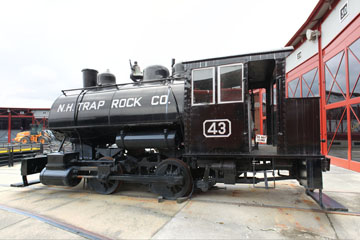
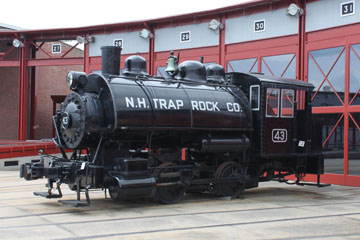
The Vulcan Iron Works began making steam locomotives in 1849. Its first diesel locomotives were built in the 1920s. Vulcan also built a large number of gasoline powered locomotives with mechanical drives, but it was never a major producer and ceased production in 1954.
#43 worked for the New Haven Trap Rock Company until 1956, when two GE diesel-electric switchers replaced steam on the run from the North Branford crusher to the Pine Orchard terminal. #43 continued to switch at the crusher and terminal until it was retired in 1959.

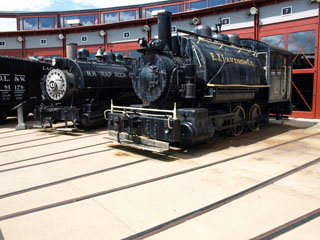
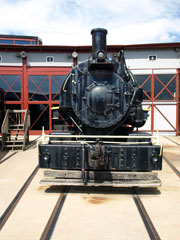

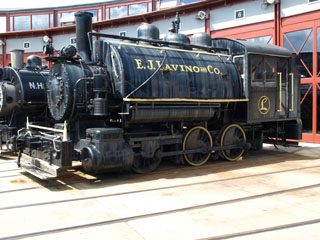
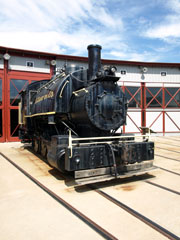
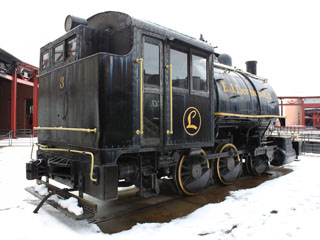
Delivered as "Poland Spring" #2 to Hiram Ricker & Sons, a spring water retailer in Poland Spring, ME, this 0-6-0T (Tank) locomotive was built by Alco in 1927. It was to haul boxes of bottled Poland Water from Ricker's Poland Spring plant to Danville, ME, for shipment, returning with passenger guests to a hotel at Poland Spring where they would enjoy the sanative qualities of the natural water, although it is not clear it ever worked in that capacity. At some time, #2 was sold to E. J. Lavino and Company, which operated a manganese blast furnace at Sheridan, PA, to switch at the plant. It worked there as #3 until 1965, when it was donated to the Steamtown Foundation.
#3 weighs 107,000 lbs and has 44" drivers and 16" x 24" cylinders. A coal burner, it operated at a boiler pressure of 180 psi delivering tractive effort of 21,720 lbs.

#8 weighs 117,970 lbs. It
has 46" drivers and the cylinders are 19" x 24".
With an operating boiler pressure of 180 psi, it delivered 22,800 lbs tractive effort.
As you can see from the photos below, the museum has cut away the engine and colour coded the various parts!
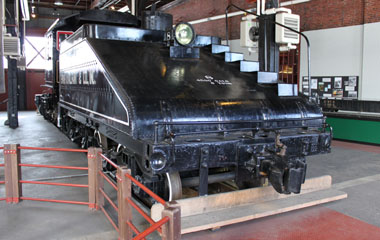


This 0-6-0 switcher was built by Baldwin for Spang, Chalfont & Company in 1923. It worked switching iron ore to the company's Etna, PA, blast furnaces, as well as pipes, tubing and steel sheeting to connections with the B&O and PRR. Some time in the 1950s, it was sold to Duquesne Slag Products in Pittsburgh, PA, where it hauled slag for concrete, ballast, road building materials, roofing and other industrial products. In 1963, it was sold to the Penn View Mountain tourist railroad in Blairsville, PA.
By 1975, #8 had become too worn out to operate. It was sold on again and, in the early 1990s, was donated to the Steamtown collection.

The G-3-a had 75" drivers for work on relatively level terrain and the G-4-a had 70" drivers for hilly terrain.
The first G-3-a appeared in 1919 and the G-3 went through nine variations to the G-3-j subclass. The CPR eventually rostered one hundred and seventy-three G-3 4-6-2 locomotives in the nine different subclasses.
As heavier all-steel passenger cars replaced lighter wooden cars in the 1920s, the Canadian Pacific needed more powerful locomotives.
Developing its earlier Pacific type (4-6-2)
G-l and G-2 classes, the CPR designed the G-3-a and G-4-a.
When I last visited, #2317 was being shopped in the roundhouse.
Above and left, the locomotive's smokebox door was open, revealing #2317's exhaust nozzle, exhaust stand, netting and petticoat pipe.

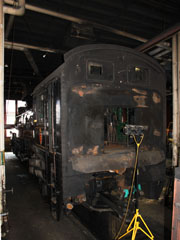

Above, with the tender uncoupled while #2317 was
being shopped, the stoker screw and connections are revealed. The open panel in the right hand photo gives a glimpse of the stoker motor. The tender weighs 178,000 lbs light and has a 9,600 gallon water and 12 ton coal capacity.
#2317 retired in 1959 and was bought by F. Nelson
Blount in 1965. The engine weighs 299,000 lbs, 181,500 lbs on its 75" drivers. With 25" x 30" cylinders, a 65 sq ft grate, 297.6 sq ft firebox and total heating surface of 3,530 sq ft including 803 sq ft superheating, #2317 operates at a boiler pressure of 200 psi delivering 42,500 lbs tractive effort.

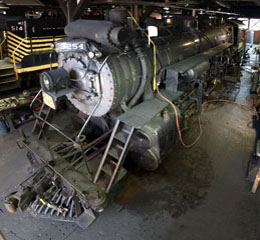
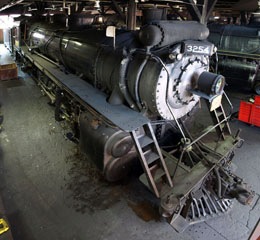
CN #3254 in the roundhouse. You can see photos of it in steam on the CN #3254 page of this website.
#3254 is an S-1-b class Mikado
(2-8-2) built at the Canadian Locomotive Company's Kingston Works in Ontario in 1917. It weighs 276,000 lbs, 205,000 lbs on its 63" drivers. With a total heating surface 4,388 sq ft and 27" x 30" cylinders, it operated at a boiler pressure of 180 psi, delivering 53,115 lbs tractive effort.

#565 weighs 161,000 lbs, 140,000 lbs on its 63" drivers. With 20½" x 26" cylinders, a 53.4 sq ft grate, 157 sq ft firebox and total heating surface of 2,019 sq ft including 341 sq ft superheating, it operated at a boiler pressure of 200 psi delivering 29,484 lbs tractive effort.
#565 is the only Steamtown engine that is on its DL&W "home turf". You can restoration on the Lackawanna 565 Restoration Project website.
#565 has been undergoing restoration for some years. It's a long, labour intensive project carried out completely by volunteers.
The locomotive was built by Alco's Rogers Locomotive Works in Paterson, NJ, as an E5 class for the Delaware, Lackawanna & Western in 1908. It is a Mogul type (2-6-0), one of a series of 2-6-0s purchased to replace earlier locomotives that the company was scrapping. Originally built with
slide valves, at some time, the DL&W replaced these with piston valves and gave #565 a superheater.
#565 worked for the Lackawanna for twenty-eight years and then, in 1936, was sold to the Dansville & Mount Morris Railroad, a nine mile shortline operating between Dansville and Groveland, NY. It worked for the D&MM until 1961, at which time the company acquired a diesel, and the steam locomotive was sold to William Whitehead for the Black River & Western Railroad, a small tourist
line operating between Ringoes and Flemington, NJ.
Over the ensuing years, #565 went through several different owners before being bought by the museum in 1985.

In May 1958, #759 was the last steam locomotive the NKP overhauled, and it was retired soon after.
F. Nelson Blount bought #759 in 1962 for his collection in Bellows Falls, VT. Ross Rowland, Jr., then carried out repairs and, on 17th August 1968, it made several trial runs. Two weeks later, it began an excursion career that lasted until 1973.
Briefly fired up at Steamtown in 1977, work was to begin on reflueing, but sponsorship fell through and the locomotive has stood cold ever since.
#759 is one of five preserved
NKP S-2s. You can see #765 in steam on the NKP #765 page of this website. You can also see NKP S-2 #757 on the Railroad Museum of Pennsylvania Yard page.
This S-2 class Berkshire (2-8-4) type locomotive was built for the Nickel Plate by Lima in 1944. It worked mainly on freight trains.
The locomotive weighs 440,800 lbs, has 69" drivers and 25" x 34" cylinders. With a 90.3 sq ft grate, 461 sq ft firebox and total heating surface of 6,810 sq ft (including 1,992 superheating), it operated at a boiler pressure of 245 psi, delivering 64,135 lbs tractive effort.


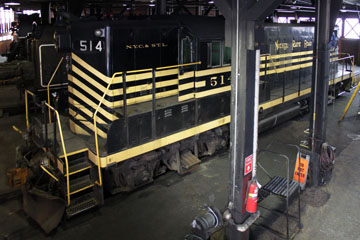

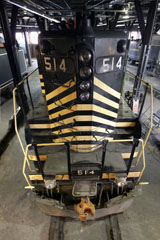
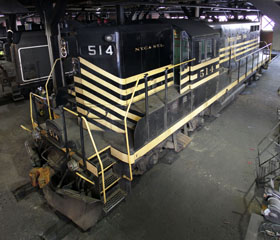
#514 was bought in 1958 by the Nickel Plate, part of an order of twenty. It joined sixty-two GP9s already owned by the NKP, and another twenty-five were ordered in 1959. You can see #532, from that final order, on the Virginia Museum of Transportation page of this website.
EMD built three thousand, four hundred and forty-four GP9s for US railroads, six hundred and forty-six for Canadian railroads and twenty-five for other countries from 1954 to 1963. US production ended in 1959, but an additional thirteen units were built by GMD in Canada, including the last two in August 1963.
When the NKP was absorbed by Norfolk & Western in 1964, #514 was renumbered #2514. After working on Norfolk Southern, #2514 was retired on 5th April 1985. It was then given to Steamtown as part of a trade that gave the Virginia Museum of Transportation title to NW A #1218 (you can see #1218 on the Virginia Museum of Transportation page of this website).
The locomotive has been restored by the museum to its original NKP livery. It is used in the Steamtown yards for switching and as a backup locomotive when the historic steam locomotives experience problems.

EMD's production run of the 600 hp S series included DL&W's two pre-SC units, forty-three SC units and seventy-six SW units. A 900 hp N series followed, comprising five NC units, five NC1, two NC2, eight NW, twenty-seven NW1, three NW1A, two NW4 and one T unit.
#426 is 44' 5" long and weighs 180,000 lbs. Its four axles are each powered by a GE 287E traction motor. With a top speed of 55 mph, it could deliver 43,000 continuous tractive effort at 11 mph.
#426 is one of the first diesel-electric switchers built by the Electro-Motive Corporation, later EMD. They were equipped with 8 cylinder Winton 201-A engines. Two pre-production SC units were built in 1935 and delivered to the Delaware, Lackawanna & Western as #425 and #426.
The two pre-SC models differ from the later production units in that the hood does not taper down to the cab. You can see the taper on later models CG SW1 #1 on the Savannah Roundhouse Railroad Museum page of this website, MSTL NW1 #D-538 on the National Railroad Museum page, and MP NW2 #81 on the Railroad Museum of Pennsylvania Yard page.
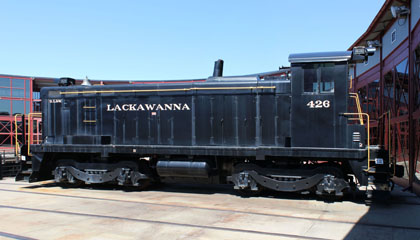


Today, WAB #132 / DLW #500 is in need of a makeover.
EMD manufactured three hundred and seventy-four SW8s between 1950 and 1954, three hundred and nine at its La Grange, IL, plant for US railroads and sixty-five at its GMD Division in Montreal for Canadian railroads. Each unit weighs 230,000 lbs and is 44' 5" long. An EMD 567B 8 cylinder prime mover powered a GM D15C generator to drive four GM D37 traction motors. They developed 36,000 lbs tractive effort at 11 mph and had a top speed of 65 mph.
Not much is known about the operational life of this EMD SW8 switcher, other than it was based at St. Louis, MO. It was built as #132 in 1953 for the Wabash and, when that railroad was taken over by the Norfolk & Western in 1964, it became NW #3132. In 1983, it was renumbered NW #3732 to avoid conflicting with the numbering of a series of EMD SD-45s.
It was repainted in Lackawanna colours and numbered #500 after arriving at Steamtown in 1987, a fictional livery and number for an engine with no historic connection to the DL&W.

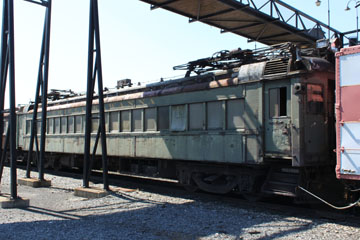
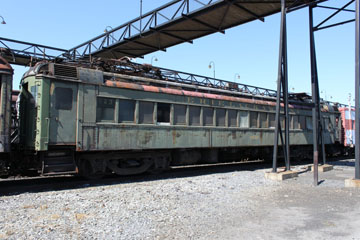
Pullman Car & Manufacturing Company built this electric car for the Delaware, Lackawanna & Western in 1930. With formation of the Erie Lackawanna in 1960, it became #3503 and then Conrail #3503 in 1976 and, finally, New Jersey Transit #3503 in 1979.
It is one of one hundred and forty-one units bought from 1930 to 1931 for the DL&W's newly electrified New Jersey suburban routes. Powered by an overhead pantograph, the 70' 2" long car had eighty-four seats, and multiple units of up to twelve cars could be controlled from the cab.

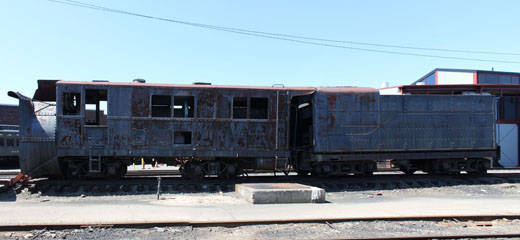
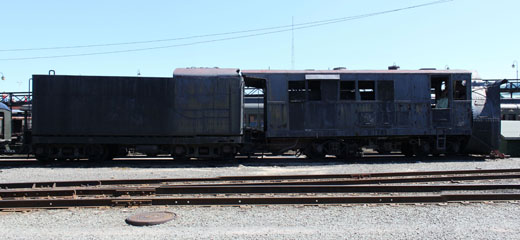
Rotary Snow Plow #193 was built by the Cooke Locomotive and Machine Works, later part of Alco, in 1898 for the Long Island Railroad, a subsidiary of the Pennsylvania Railroad. It was retired in 1965 and bought by private owners in 1968. In 1988, it was sold to Steamtown.
#193 weighs 67½ tons and has a blade assembly with a radius of 9' 8". It is the only surviving steam rotary snow plow that was used on a railroad east of the Mississippi.

#5 is on display with CNJ Idler Gondola #92082, which has been with the derrick since at least the mid 1960s.
Founded in the city of Bucyrus, OH, in 1880, the company was an early producer of steam shovels. In 1927, it merged with the Erie Steam Shovel Company to form Bucyrus-Erie. It is still in existence and is now a major, NASDAQ listed company. You can see other Bucyrus built equipment on the North Carolina Transportation Museum page of this website and the Lake Superior Railroad Museum page.
Built in 1918 by the Bucyrus Company for the Central Railroad of New Jersey, #5 has a 150 ton lifting capacity.
The derrick spent most of its operating life in north east Pennsylvania and became part of the Steamtown Foundation
in Bellows Falls, VT, in 1976.
Related Links:
Steamtown NPS Website
Union Pacific Historical Society
Reading Railroad Heritage Museum
Reading Railroad Online
Grand Trunk Western Historical Society
Illinois Central Net
Nickel Plate Road Historical & Technical Society
Delaware, Lackawanna & Western Railroad Historical Society
Maine Central Railroad Page
Long Island Rail Road History Website
Send a comment or query, or request permission to re-use an image.
The NPS commissioned a special history study Steam Over Scranton in 1991. Written by Gordon Chappell, it has a wealth of information and historic photos of the collection (click on the cover to search for this book on Bookfinder.com).

It is also available on line at





